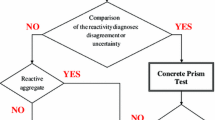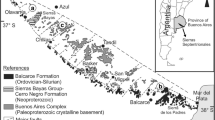Abstract
Concretes which have expanded and cracked because of the alkali-aggregate reaction or because of sulphate attack caused by the use of sulphide-bearing aggregate both display white reaction products in the matrix and on fracture planes in the aggregates, but the reaction mechanism and reaction products are entirely different.
Petrographic microscopy clearly differentiates between potentially alkali-reactive siliceous and potentially expansive sulphidebearing aggregates and XRD and SEM both differentiate between the reaction products.
Burnt clay aggregate suffering from moisture expansion can cause concrete to expand and crack.
A test method employing a domestic pressure cooker for checking the presence of quicklime in by-product aggregate is mentioned.
Résumé
Les bétons qui se dilatent et se fissurent à cause d'une réaction alcaline du granulat ou à cause d'une attaque par les sulfates causée par l'emploi de granulats contenant des sulfures montrent tous des produits de réaction blancs dans la matrice et sur les plans de fracture des granulats, bien que le mécanisme de réaction et les produits de réaction soient complètement différents.
La microscopie permet d'établir une distinction très nette entre les éléments siliceux potentiellement réactifs aux alcalis et les granulats contenant des sulfures potentiellement capables de dilatation; une diffraction X et une microscopie électronique permettent de différencier les produits de réaction.
Un granulat d'argile expansée qui se dilate sous l'action de l'humidité peut conduire le béton à se dilater et à se fissurer.
Cet article fait mention d'une méthode d'essai utilisant un auto-cuiseur pour contrôler la présence de chaux vive dans les granulats de sous-produits.
Similar content being viewed by others
References
BOUCHER P.S. and HOWDEN M.G. (1973): Towards understanding moisture expansion in bricks and glazed ceramics. Proceedings of S.A. Ceramic Society symposium 1–11, Johannesburg, South Africa.
BOUCHER P.S., FROST L.J. and HOWDEN M.G. (1977): Moisture expansion of ceramic products. Part 1: Rapid method for determining the unrestrained moisture expansion of burnt clay bricks. CSIR Research Report 336, 1–10.
DOLAR-MANTUANI L.M.M. (1981): Undulatory extinction in quartz used for identifying potentially alkali-reactive rocks. Proceedings Fifth International Conference on Alkali-Aggregate Reaction in Concrete, Cape Town, South Africa. (CSIR Ref. No. S252/36).
LORD C.J. (1982): A selective and precise method for pyrite determination in sedimentary materials. Jour. Sed. Petrol. Vol. 52, No 2, 664–666.
OBERHOLSTER R.E., VAN AARDT J.H.P. and BRANDT M.P. (1983): Chapter 8, Durability of cementitious systems. Structure and Performance of Cement, P Barnes, Ed. Applied Science Publishers, London, 265–413.
ROSSOUW A.F.G., KRÜGER J.E. and VAN DIJK J. (1981): Report on the suitability of some metallurgical slags as aggreagate for concrete. NBRI Special Report BOU 56, 1–25, Pretoria, South Africa.
SOUTH AFRICAN BUREAU OF STANDARDS AMENDMENT No 3 (1980): Standard specification for burt clay masonry units. SABS 227-1970, 1–17, Pretoria, South Africa.
STUBBS R. and PUTTERILL K.E. (1972): Expansion of brickwork. CSIR Research Report 259, 1–32, Pretoria, South Africa.
VAN AARDT J.H.P. and VISSER S. (1982): reaction between rocks and the hydroxides of calcium, sodium and potassium: Progress Report No 2. Identification of reaction products and a study of the dimensional changes of cementbonded mortar specimens immersed in alkali solutions at 40°C and 80°C. CSIR Research Report 577, 1–34. Pretoria, South Africa.
VAN RENSBURG J.J.J., KRÜGER J.E. and BROOKS W.H.B. (1983): The presence and detection of quicklime nodules in cliniker ash and slag aggregate. NBRI Special Report BOU 64, 1–16, Pretoria, South Africa.
Author information
Authors and Affiliations
Rights and permissions
About this article
Cite this article
Oberholster, R.E., Krüger, J.E. Investigation of alkali-reactive, sulphide-bearing and by-product aggregates. Bulletin of the International Association of Engineering Geology 30, 273–277 (1984). https://doi.org/10.1007/BF02594323
Published:
Issue Date:
DOI: https://doi.org/10.1007/BF02594323




